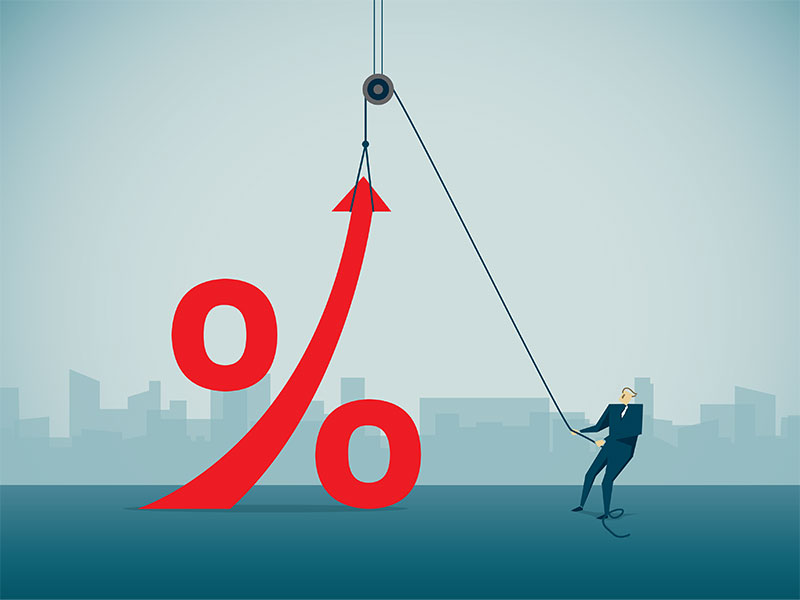
What will happen when interest rates rise? That seems a strange question, for we remain on a downslope of rates dropping, which they have done (with a few wobbles) since 1983. Manipulations by central banks have added more money to the supply of loanable funds. The monetary climate within the G-8 seems to be on a permanent Boxing Day sale, and there’s no prospect of that changing anytime soon.
The main reason for interest rates declining is central banks’ policies, such as bond buybacks that have injected cash into the money supply. Demand for loanable funds has been tepid for investments in such things as energy projects in Canada.
But demand for cash has been strong in corporate finance. Companies have used low interest rates to borrow heavily to finance stock buybacks. Interest paid is deductible from operating income. However, with fewer shares, earnings per share and executive officers’ compensation have risen. Rock-bottom interest rates seem to be a win/win to big borrowers.
The process of returning to normal rates will be slow because low rates have cut yields on bank deposits and thus, paradoxically, prodded people to save even more for retirement. Moreover, administered low short rates have had a strong effect on bringing down long market rates of interest.
This low-rate period cannot go on forever, because few people wish to accept being paid nothing for postponing consumption.
Eventually, rising interest rates will make companies reverse their borrowing. Companies will see their bottom lines shrink, yet they will have to sell shares to get money to pay down debt. With more shares to use to distribute income, earnings per share numbers will drop. That means stock prices will drop.
The world will return to the norm of positive real rates of interest. The problem with this “day of reckoning” theory is that it is an outlier, not part of the consensus. The new view is that lots of cash on the sidelines is a good thing – a merit badge in corporate finance.
“The amount of cash companies have is at a record-high,” says Benjamin Tal, deputy chief economist with Canadian Imperial Bank of Commerce in Toronto. “This is not excess cash. Rather, it is what they need to buy into the debt market.”
Under this theory, a strong balance sheet should be cash-heavy. Investors and credit raters like to see lots of liquidity.
Not only do companies not want to part with their cash, the trigger for a rise in short rates is absent. Inflation can push central banks to manipulate front-end interest rates. U.S. consumer prices in November 2019 rose by 2.1% over those at the same time a year earlier.
In the same month, consumer prices rose by 2.2% in Canada, by 0.2% in Japan, by 1.5% in the U.K. and by 1.0% for the eurozone; they dropped by 0.1% in Switzerland. Therefore, there is little case for higher administered short rates in the major monetary markets of the world.
The trigger for higher interest rates would have to be a sustained lift in inflation rates above 2.0%, says Michael Gregory, deputy chief economist with Bank of Montreal in Toronto. “Policy rates could go lower,” Gregory says. “Credit spreads [the difference between short and long rates] are tight, so there is a limit [to] how much rates could rise.”
Add to that the global savings glut, which has contributed to low rates, and the case for higher rates occurring anytime soon is weak.
Despite the fact that rates won’t rise unless inflation picks up, nominal rates are low or negative in all major countries. Real rates are actually negative in all major markets. Change can happen if increases in government spending are not matched by increases in productivity or taxation.
Alternatively, there could be reductions in globalization that lower productivity and raise costs, says Chris Kresic, head of fixed-income and asset allocation with Jarislowsky Fraser Ltd. in Toronto.
For now, the problem in wealthy economies is excess saving with no way to absorb it in productive enterprise. We remain in a phase during which there is too much money being sought by too little enterprise. Moreover, the winners in today’s economy, such as high-tech, are light on capital, and that also reduces the demand for money.
Eventually, money stored in bills, bonds and banks at a few percent in Canada and the U.S. (or at negative rates in Europe) has to return to being a commodity that somebody wants. At the moment, low inflation and precautionary monetary policy are restraining the U.S. Federal Reserve Board from raising rates, says Josh Nye, senior economist with Royal Bank of Canada in Toronto: “The Fed’s interest rate policy of rate reductions this year has been about insurance against hits from trade policy.”
When rates do rise, companies will rush to pay off loans and bonds, and markets engineered by low rates will shrink. A return to positive real interest rates will hurt companies that have borrowed heavily and benefit a few, such as banks, which have had a hard time making a profit on the small differences between what they pay to borrow and what they charge to lend.
“In [the thinking of] monetary think-tanks, negative interest rates can stimulate growth. But in the real world, people are not going to save money forever with negative returns on money,” Kresic says.
“Negative rates raise precautionary savings and crush demand,” Kresic adds. “Negative rates are self-limiting. The only question is when the curtain will come down on this odd episode in financial history.”